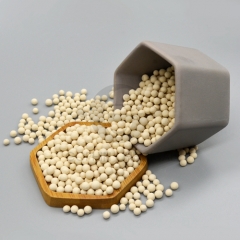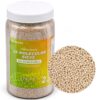Description
3A Molecular Sieve: The Dehydrating Workhorse of Industry
In the world of industrial separation and purification, molecular sieves play a crucial role. Among these workhorses, the 3A molecular sieve stands out for its specific pore size and exceptional ability to selectively adsorb water. This article delves into the properties, applications, and advantages of this versatile material.
What is a 3A Molecular Sieve?
A 3A molecular sieve is a synthetic crystalline aluminosilicate material with a defined pore size of 3 Angstroms (0.3 nanometers). This precise pore size is achieved by modifying the crystal structure of a naturally occurring zeolite. Specifically, the potassium form of the Type A crystal structure is used, resulting in a framework where only molecules smaller than 3 Angstroms can enter the internal channels.
The Power of Selective Adsorption
The key to the 3A molecular sieve’s effectiveness lies in its ability to selectively adsorb molecules based on their size and polarity. Its 3 Angstrom pore size allows water molecules (diameter approximately 2.8 Angstroms) to be readily adsorbed, while blocking larger molecules. This makes it an ideal desiccant, capable of removing water vapor from various gas and liquid streams.
Key Properties and Advantages:
- High Water Adsorption Capacity: 3A sieves exhibit a high affinity for water, enabling them to efficiently remove moisture even at low concentrations.
- Selective Adsorption: The precisely controlled pore size ensures that only molecules smaller than 3 Angstroms are adsorbed, minimizing interference from other components.
- Chemical Stability: 3A sieves are resistant to many common chemicals, offering durability and longevity in various applications.
- Thermal Stability: They can withstand high temperatures, making them suitable for use in processes that involve heating and cooling cycles.
- Regenerative Properties: Once saturated with water, 3A sieves can be regenerated by heating, allowing for repeated use and reducing waste.
Wide-Ranging Applications:
The unique properties of 3A molecular sieves make them invaluable in a diverse array of industrial applications, including:
- Dehydration of Unsaturated Hydrocarbons: Effectively removes water from cracked gas, propylene, butadiene, and acetylene, preventing the formation of hydrates and corrosion.
- Drying of Natural Gas: Ensures that natural gas pipelines are free from moisture, preventing hydrate formation and pipeline corrosion.
- Drying of Refrigerants: Removes moisture from refrigerants to maintain their performance and prevent damage to refrigeration systems.
- Drying of Insulating Glass: Used in the production of insulated glass units to absorb any residual moisture between the glass panes, preventing condensation and maintaining clarity.
- Drying of Liquid Alcohols: Removes water from ethanol and other alcohols used in various chemical processes and fuel applications.
- Pharmaceutical and Medical Applications: Used for drying solvents and intermediates in the production of pharmaceuticals and medical devices.
- Air Drying: Used in compressed air dryers for removing water vapor providing dry air required for various industrial processes.
Regeneration and Maintenance:
To maintain the efficiency of 3A molecular sieves, regular regeneration is essential. This process involves heating the saturated sieve to drive off the adsorbed water. Common regeneration methods include:
- Thermal Swing Adsorption (TSA): Heating the sieve with a hot gas stream.
- Pressure Swing Adsorption (PSA): Reducing the pressure to desorb the water.
- Temperature-Pressure Swing Adsorption (TPSA): Combining temperature and pressure changes to enhance regeneration.
The specific regeneration conditions (temperature, pressure, and flow rate) depend on the application and the operating environment.
Conclusion:
3A molecular sieves are a cornerstone of many industrial processes requiring selective dehydration. Their consistent performance, chemical stability, and regenerative properties make them a cost-effective and reliable solution for removing water from a wide range of gas and liquid streams. As industries continue to demand cleaner and more efficient processes, the demand for 3A molecular sieves will undoubtedly remain strong, solidifying their position as a vital component in the chemical processing landscape.



















Reviews
There are no reviews yet.